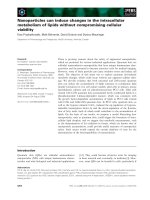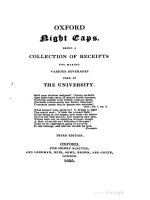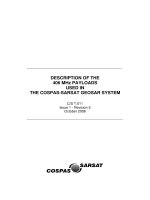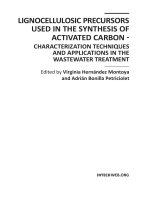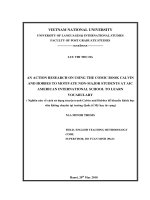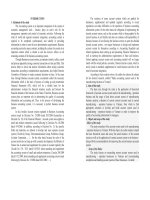An3154 can protocol used in the stm32 bootloader stmicroelectronics
Bạn đang xem bản rút gọn của tài liệu. Xem và tải ngay bản đầy đủ của tài liệu tại đây (609.52 KB, 34 trang )
AN3154
Application note
CAN protocol used in the STM32 bootloader
Introduction
This application note describes the CAN protocol used in the STM32 microcontroller
bootloader. It details each supported command.
This document applies to the STM32 products embedding bootloader versions V3.x, V7.x
and V9.x, as specified in STM32 microcontroller system memory boot mode (AN2606)
available on www.st.com. These products are listed in Table 1, and are referred to as
STM32 throughout the document.
For more information about the CAN hardware resources and requirements for the
bootloader of the used device, refer to the already mentioned AN2606.
Table 1. Applicable products
Type
Part number or product series
STM32F1 Series
STM32F2 Series
Microcontrollers STM32F4 Series
STM32F7 Series
STM32L4 Series
June 2021
AN3154 Rev 8
1/34
www.st.com
Contents
AN3154
Contents
1
Bootloader code sequence . . . . . . . . . . . . . . . . . . . . . . . . . . . . . . . . . . . 5
2
CAN settings . . . . . . . . . . . . . . . . . . . . . . . . . . . . . . . . . . . . . . . . . . . . . . . 7
3
Bootloader command set . . . . . . . . . . . . . . . . . . . . . . . . . . . . . . . . . . . . . 8
3.1
Get command . . . . . . . . . . . . . . . . . . . . . . . . . . . . . . . . . . . . . . . . . . . . . . . 8
3.2
Get Version & Read Protection Status command . . . . . . . . . . . . . . . . . . .11
3.3
Get ID command . . . . . . . . . . . . . . . . . . . . . . . . . . . . . . . . . . . . . . . . . . . 13
3.4
Speed command . . . . . . . . . . . . . . . . . . . . . . . . . . . . . . . . . . . . . . . . . . . 14
3.5
Read Memory command . . . . . . . . . . . . . . . . . . . . . . . . . . . . . . . . . . . . . 17
3.6
Go command . . . . . . . . . . . . . . . . . . . . . . . . . . . . . . . . . . . . . . . . . . . . . . 18
3.7
Write Memory command . . . . . . . . . . . . . . . . . . . . . . . . . . . . . . . . . . . . . 20
3.8
Erase Memory command . . . . . . . . . . . . . . . . . . . . . . . . . . . . . . . . . . . . . 23
3.9
Write Protect command . . . . . . . . . . . . . . . . . . . . . . . . . . . . . . . . . . . . . . 25
3.10
Write Unprotect command . . . . . . . . . . . . . . . . . . . . . . . . . . . . . . . . . . . . 26
3.11
Readout Protect command . . . . . . . . . . . . . . . . . . . . . . . . . . . . . . . . . . . . 28
3.12
Readout Unprotect command . . . . . . . . . . . . . . . . . . . . . . . . . . . . . . . . . 30
4
Bootloader protocol version evolution . . . . . . . . . . . . . . . . . . . . . . . . . 32
5
Revision history . . . . . . . . . . . . . . . . . . . . . . . . . . . . . . . . . . . . . . . . . . . 33
2/34
AN3154 Rev 8
AN3154
List of tables
List of tables
Table 1.
Table 2.
Table 3.
Table 4.
Applicable products . . . . . . . . . . . . . . . . . . . . . . . . . . . . . . . . . . . . . . . . . . . . . . . . . . . . . . . 1
CAN bootloader commands . . . . . . . . . . . . . . . . . . . . . . . . . . . . . . . . . . . . . . . . . . . . . . . . . 8
Bootloader protocol versions . . . . . . . . . . . . . . . . . . . . . . . . . . . . . . . . . . . . . . . . . . . . . . . 32
Document revision history . . . . . . . . . . . . . . . . . . . . . . . . . . . . . . . . . . . . . . . . . . . . . . . . . 33
AN3154 Rev 8
3/34
3
List of figures
AN3154
List of figures
Figure 1.
Figure 2.
Figure 3.
Figure 4.
Figure 5.
Figure 6.
Figure 7.
Figure 8.
Figure 9.
Figure 10.
Figure 11.
Figure 12.
Figure 13.
Figure 14.
Figure 15.
Figure 16.
Figure 17.
Figure 18.
Figure 19.
Figure 20.
Figure 21.
Figure 22.
Figure 23.
Figure 24.
Figure 25.
Figure 26.
Figure 27.
4/34
Bootloader for STM32 with CAN. . . . . . . . . . . . . . . . . . . . . . . . . . . . . . . . . . . . . . . . . . . . . . 5
Check HSE frequency . . . . . . . . . . . . . . . . . . . . . . . . . . . . . . . . . . . . . . . . . . . . . . . . . . . . . 6
CAN frame . . . . . . . . . . . . . . . . . . . . . . . . . . . . . . . . . . . . . . . . . . . . . . . . . . . . . . . . . . . . . . 7
Get command: host side . . . . . . . . . . . . . . . . . . . . . . . . . . . . . . . . . . . . . . . . . . . . . . . . . . . . 9
Get command: device side . . . . . . . . . . . . . . . . . . . . . . . . . . . . . . . . . . . . . . . . . . . . . . . . . 10
Get Version & Read Protection Status command: host side . . . . . . . . . . . . . . . . . . . . . . . 11
Get Version & Read Protection Status command: device side. . . . . . . . . . . . . . . . . . . . . . 12
Get ID command: host side . . . . . . . . . . . . . . . . . . . . . . . . . . . . . . . . . . . . . . . . . . . . . . . . 13
Get ID command: device side. . . . . . . . . . . . . . . . . . . . . . . . . . . . . . . . . . . . . . . . . . . . . . . 14
Speed command: host side . . . . . . . . . . . . . . . . . . . . . . . . . . . . . . . . . . . . . . . . . . . . . . . . 15
Speed command: device side. . . . . . . . . . . . . . . . . . . . . . . . . . . . . . . . . . . . . . . . . . . . . . . 16
Read memory command: host side . . . . . . . . . . . . . . . . . . . . . . . . . . . . . . . . . . . . . . . . . . 17
Read memory command: device side . . . . . . . . . . . . . . . . . . . . . . . . . . . . . . . . . . . . . . . . 18
Go command: host side . . . . . . . . . . . . . . . . . . . . . . . . . . . . . . . . . . . . . . . . . . . . . . . . . . . 19
Go command: device side . . . . . . . . . . . . . . . . . . . . . . . . . . . . . . . . . . . . . . . . . . . . . . . . . 20
Write Memory command: host side . . . . . . . . . . . . . . . . . . . . . . . . . . . . . . . . . . . . . . . . . . 21
Write memory command: device side. . . . . . . . . . . . . . . . . . . . . . . . . . . . . . . . . . . . . . . . . 22
Erase Memory command: host side . . . . . . . . . . . . . . . . . . . . . . . . . . . . . . . . . . . . . . . . . . 23
Erase Memory command: device side . . . . . . . . . . . . . . . . . . . . . . . . . . . . . . . . . . . . . . . . 24
Write Protect command: host side . . . . . . . . . . . . . . . . . . . . . . . . . . . . . . . . . . . . . . . . . . . 25
Write Protect command: device side . . . . . . . . . . . . . . . . . . . . . . . . . . . . . . . . . . . . . . . . . 26
Write Unprotect command: host side . . . . . . . . . . . . . . . . . . . . . . . . . . . . . . . . . . . . . . . . . 27
Write Unprotect command: device side . . . . . . . . . . . . . . . . . . . . . . . . . . . . . . . . . . . . . . . 27
Readout Protect command: host side. . . . . . . . . . . . . . . . . . . . . . . . . . . . . . . . . . . . . . . . . 28
Readout Protect command: device side . . . . . . . . . . . . . . . . . . . . . . . . . . . . . . . . . . . . . . . 29
Readout Unprotect command: host side . . . . . . . . . . . . . . . . . . . . . . . . . . . . . . . . . . . . . . 30
Readout Unprotect command: device side . . . . . . . . . . . . . . . . . . . . . . . . . . . . . . . . . . . . . 31
AN3154 Rev 8
AN3154
1
Bootloader code sequence
Bootloader code sequence
Figure 1. Bootloader for STM32 with CAN
Frame detected(1)
on CANx_Rx pin
Check HSE frequency
Wait for a
command
Command
received
GET cmd
GET cmd
routine
RD cmd
routine
(optional)
Routines for
loading
into RAM
GO cmd
GO cmd
routine
JP to_Address
ai17754b
1. It is recommended to send a frame with a Standard ID = 0x79.
Once the system memory boot mode is entered and the STM32 device (based on Arm®(a)
cores) has been configured (for more details refer to AN2606), the bootloader code waits for
a frame on the CANx_Rx pin. When a detection occurs the CAN bootloader firmware starts
to check the external clock frequency.
Figure 2 shows the flowchart of the frequency check.
a. Arm is a registered trademark of Arm Limited (or its subsidiaries) in the US and/or elsewhere.
AN3154 Rev 8
5/34
33
Bootloader code sequence
AN3154
Figure 2. Check HSE frequency
Start check HSE frequency
HSE measured with HSI
and Timer (1)
No HSE measurement (1)
Configure CAN baudrate at 125 Kbps
Assuming that HSE = 8 MHz
Initialize timeout at ~1.5 ms
Message
received with stdID=0x79
and without frame error?
Configure external Oscillator mode
(System Clock = 60 MHz)
Initialize timeout at ~3 ms
Yes
Yes
No
Message
received with stdID=0x79
and without frame error
?
No
No
No
Decrement timeout
Timeout=0x0?
Decrement timeout
Timeout = 0x0 ?
Yes
Yes
Configure CAN baudrate at 125Kbps
Assuming that HSE = 25MHz
Initialize timeout at ~1.5 ms
Message
received with stdID=0x79
and without frame error
?
Generate System Reset
Yes
No
No
Decrement timeout
Timeout = 0x0 ?
Yes
Configure CAN baudrate at 125Kbps
Assuming that HSE = 14.7456MHz
Initialize timeout at ~1.5 ms
Message
received with stdID=0x79
and without frame error
?
Yes
No
No
Decrement timeout
Timeout = 0x0 ?
Yes
Enter an infinite loop, waiting for any
CAN bootloader command.
Generate System Reset
ai15704c
1. For some devices the HSE frequency is calculated using HSI oscillator connected to a timer. For other
devices this measurement is not implemented. For the devices without HSE frequency measurement, only
the flow represented on the left is executed, while for the devices with HSE frequency measurement only
the flow on the right is executed. To know the flow for the used device refer to AN2606.
6/34
AN3154 Rev 8
AN3154
CAN settings
Next, the code initializes the serial interface accordingly. Using this calculated baud rate, an
acknowledge byte (0x79) is returned to the host, indicating that the STM32 is ready to
receive commands.
2
CAN settings
The STM32 CAN is compliant with the 2.0A and B (active) specifications with a bit rate up to
1 Mbit/s. It can receive and transmit standard frames with 11-bit identifiers as well as
extended frames with 29-bit identifiers.
Figure 3 shows a CAN frame that uses the standard identifier only.
Figure 3. CAN frame
Inter-frame space
or overload frame
Data frame (standard identifier)
44 + 8 * N
Inter-frame space
Control field
6
CRC field
16
DLC
ACK field
2
CRC
7
EOF
ACK
SOF
ID
Data field
8*N
RTR
IDE
r0
Arbitration field
12
ai15001
In this application the CAN settings are:
Standard identifier (not extended)
Bit rate: at the beginning it is 125 kbps; during runtime it can be changed via the speed
command to achieve a maximum bit rate of 1 Mbps.
The transmit settings (from the STM32 to the host) are:
Tx mailbox0: On
Tx mailbox1 and Tx mailbox2: Off
Tx identifier: (0x00, 0x01, 0x02, v03, 0x11, 0x21, 0x31, 0x43, 0x63, 0x73, 0x82, 0x92)
The receive settings (from the host to the STM32) are:
Note:
Synchronization byte, 0x79, is in the RX identifier and not in the data field.
RX identifier depends on the command (0x00, 0x01, 0x02, 0x03, 0x11, 0x21, 0x31,
0x43, 0x63, 0x73, 0x82, 0x92)
Error checking: If the error field (bit [6:4] in the CAN_ESR register) is different from
000b, the message is discarded and a NACK is sent to the host
In FIFO overrun condition, the message is discarded and a NACK is sent to the host
Incoming messages can contain from 1 to 8 data bytes.
The CAN bootloader firmware supports only one node at a time. This means that CAN
network management is not supported by the firmware.
AN3154 Rev 8
7/34
33
Bootloader command set
3
AN3154
Bootloader command set
The supported commands are listed in Table 2, each of them is described in this section.
Table 2. CAN bootloader commands
Command
Command code
Command description
Get(1)
0x00
Gets the version and the allowed commands
supported by the current version of the bootloader
Get Version &
Read Protection Status(1)
0x01
Gets the bootloader version and the Read Protection
status of the Flash memory
Get ID(1)
0x02
Gets the chip ID
Speed
0x03
The speed command allows the baud rate for CAN
run-time to be changed.
Read Memory(2)
0x11
Reads up to 256 bytes of memory starting from an
address specified by the application
Go(2)
0x21
Jumps to user application code located in the internal
Flash memory or in SRAM
Write Memory(2)
0x31
Writes up to 256 bytes to the RAM or Flash memory
starting from an address specified by the application
Erase(2)
0x43
Erases from one to all the Flash memory sectors
Write Protect
0x63
Enables the write protection for some sectors
Write Unprotect
0x73
Disables the write protection for all Flash memory
sectors
Readout Protect(1)
0x82
Enables the read protection
Readout Unprotect(1)
0x92
Disables the read protection
1. Read protection – When the RDP (read protection) option is active, only this limited subset of commands is
available. All other commands are NACK-ed and have no effect on the device. Once the RDP has been
removed, the other commands become active.
2. Refer to STM32 product datasheet and AN2606 to know the memory spaces valid for these commands.
Communication safety
Each packet is either accepted (ACK answer) or discarded (NACK answer):
3.1
ACK message = 0x79
NACK message = 0x1F
Get command
The Get command allows the host to get the version of the bootloader and the supported
commands. When the bootloader receives this command, it transmits the bootloader
version and the supported command codes to the host.
8/34
AN3154 Rev 8
AN3154
Bootloader command set
Figure 4. Get command: host side
Start of Get command
Send message with std ID = 00h
Wait for
ACK or NACK
NACK
ACK
Receive message: Number of bytes (version + commands)
Receive message: Bootloader version
Receive message: Get command
Receive message: Get Version & Read Protection Status command
Receive message: Get ID command
Receive message: Speed command
Receive message: Read Memory command
Receive message: Go command
Receive message: Write Memory command
Receive message: Erase Memory command
Receive message: Write Protect command
Receive message: Write Unprotect command
Receive message: Readout Protect command
Receive message: Readout Unprotect command
Wait for
ACK or NACK
End of Get command
MS45414V1
The host sends messages as follows:
Command message: Std ID = 0x00, data length code (DLC) = ‘not important’.
AN3154 Rev 8
9/34
33
Bootloader command set
AN3154
Figure 5. Get command: device side
Start get command
Received message
with ID = 0x00?
No
Yes
Send ACK message
Send NACK message
Send 1 message: Number of bytes
(version + commands)
Send 1 message: Bootloader version
Send 12 messages: Supported commands
Send ACK message
End of get command
ai15706
The STM32 sends messages as follows:
Message 1:
Std ID = 0x00, DLC = 1, data = 0x79 - ACK
Message 2:
Std ID = 0x00, DLC = 1 data = N = 12 = the number of bytes to be sent -1
(1 N + 1 256)
Message 3:
Std ID = 0x00, DLC = 1, data = bootloader version (0 < version 255)
Message 4:
Std ID = 0x00, DLC = 1, data = 0x00 - Get command
Message 5:
Std ID = 0x00, DLC = 1, data = 0x01 - Get Version & Read Protection
Status command
10/34
Message 6:
Std ID = 0x00, DLC = 1, data = 0x02 - Get ID command
Message 7:
Std ID = 0x00, DLC = 1, data = 0x03 - Speed command
Message 8:
Std ID = 0x00, DLC = 1, data = 0x11 - Read memory command
Message 9:
Std ID = 0x00, DLC = 1, data = 0x21 - Go command
Message 10:
Std ID = 0x00, DLC = 1, data = 0x31 - Write memory command
Message 11:
Std ID = 0x00, DLC = 1, data = 0x43 - Erase memory command
Message 12:
Std ID = 0x00, DLC = 1, data = 0x63 - Write Protect command
Message 13:
Std ID = 0x00, DLC = 1, data = 0x73 - Write Unprotect command
AN3154 Rev 8
AN3154
3.2
Bootloader command set
Message 14:
Std ID = 0x00, DLC = 1, data = 82h - Readout Protect command
Message 15:
Std ID = 0x00, DLC = 1, data = 92h - Readout Unprotect command
Message 16:
Std ID = 0x00, DLC = 1, data = 0x79 - ACK
Get Version & Read Protection Status command
The Get Version & Read Protection Status command is used to get the bootloader version
and the read protection status. When the bootloader receives the command, it transmits the
information described below (version and two dummy bytes having value 0x00) to the host.
Figure 6. Get Version & Read Protection Status command: host side
Start GV(1)
Send message with std ID = 0x01
Wait for ACK
or NACK
NACK
ACK
Receive 1 message: Bootloader version
Receive 1 message:
2 dummy bytes having value 0x00
Wait for ACK
or NACK
NACK
ACK
End of GV(1)
ai15707V2
1. GV = Get Version & Read Protection Status.
The host sends messages as follows:
Command message: Std ID = 0x01, data length code (DLC) = ‘not important’.
ACK Message contain: Std ID = 0x01, DLC = 1, data = 0x79 - ACK
AN3154 Rev 8
11/34
33
Bootloader command set
AN3154
Figure 7. Get Version & Read Protection Status command: device side
Start GV (1)
Received message
with std ID =
0x01?
No
Send NACK message
Yes
Send ACK byte
Send 1 message: bootloader version
Option message
Send ACK message
End of GV(1)
ai15708
1. GV = Get Version & Read Protection Status.
The STM32 sends messages as follows:
Message 1: Std ID = 0x01, DLC = 1, data = ACK
Message 2: Std ID = 0x01, DLC = 1, data[0] = bootloader version (0 < version 255),
example: 0x10 = Version 1.0
Message 3: Option message 1: Std ID = 0x01, DLC = 2, data = 0x00 (byte1 and byte 2)
Message 4: Std ID = 0x01, DLC = 1, data = ACK
12/34
AN3154 Rev 8
AN3154
3.3
Bootloader command set
Get ID command
The Get ID command is used to get the version of the chip ID (identification). When the
bootloader receives the command, it transmits the product ID to the host.
Figure 8. Get ID command: host side
Start GID (1)
Send message with std ID = 0x02
Wait for ACK
or NACK
NACK
ACK
Receive message 1:
data field contains the PID
Wait for ACK
or NACK
NACK
ACK
End of GID(1)
ai15710
1. GID = Get ID.
2. PID stands for product ID. Byte 1 is the MSB and byte 2, the LSB of the address. Refer to Section 3.1: Get
command for more details about the PID of the used device.
The host sends messages as follows:
Command message: Std ID = 0x02, data length code (DLC) = ‘not important’.
ACK Message contains: Std ID = 0x02, DLC = 1, data = 0x79 - ACK
AN3154 Rev 8
13/34
33
Bootloader command set
AN3154
Figure 9. Get ID command: device side
Start GID (1)
Received message
with std ID =
0x02?
No
Send NACK message
Yes
Send ACK message
Send message 1: PID
Send ACK byte
End of GID(1)
ai15711
1. GID = Get ID.
2. PID stands for product ID. Byte 1 is the MSB and byte 2 is LSB of the address.
The STM32 sends the bytes as follows:
3.4
Message 1:
Std ID = 0x02, DLC = 1, data = ACK with DLC except for current message
and ACKs.
Message 2:
Std ID = 0x02, DLC = N (the number of bytes – 1. For STM32, N = 1),
data = PID with byte 0 is MSB and byte N is the LSB of the product ID
Message 3:
Std ID = 0x02, DLC = 1, data = ACK = 0x79
Speed command
The speed command allows the baud rate for CAN run-time to be changed. It can be used
only if CAN is the peripheral being used.
A system reset is generated if the CAN receives the correct message but the operation to
set the new baud rate fails, which prevents it from entering or leaving initialization mode.
14/34
AN3154 Rev 8
AN3154
Bootloader command set
Figure 10. Speed command: host side
Start speed command
Send speed message (std ID = 0x03)
Wait for ACK
or NACK
NACK
ACK
Changes the CAN baud rate
according to command sent
Wait for ACK
End of speed
ai15712
1. After setting the new baud rate, the bootloader sends the ACK message. Therefore, the host sets its baud
rate while waiting for the ACK.
The host sends the message as follows:
Command message: Std ID = 0x03, DLC = 0x01, data[0] = XXh where XXh takes the
following values depending on the baud rate to be set:
0x01: baud rate = 125 kbps
0x02: baud rate = 250 kbps
0x03: baud rate = 500 kbps
0x04: baud rate = 1 Mbps
AN3154 Rev 8
15/34
33
Bootloader command set
AN3154
Figure 11. Speed command: device side
Start speed command
Received a message
with std ID = 0x03
and with valid
data?
No
Send NACK message
(old baud rate)
Yes
Send ACK message
(old baud rate)
End of speed command
Changes the CAN baud rate according
to received data (new baud rate)
Baudrate set correctly?
Yes
No
Generate system reset
Send ACK message
(new baud rate)
End of speed command
ai15713
The STM32 sends the bytes as follows:
16/34
Message 1:
Std ID = 0x03, DLC = 1, data[0] = ACK= 0x79: with old baud rate if the
receive message is correct else data[0] = NACK= 0x1F
Message 2:
Std ID = 0x03, DLC = 1, data[0] = ACK = 0x79 with new baud rate
AN3154 Rev 8
AN3154
3.5
Bootloader command set
Read Memory command
The Read Memory command is used to read data from any valid memory address in RAM,
Flash memory and in the information block (System memory or option byte areas).
When the bootloader receives the Read Memory command, it starts to verify the contents of
the message:
ID of the command is correct or not
ReadOutProtection is disabled or enabled
Address to be read is valid or not
If the message content is correct it transmits an ACK message otherwise it transmits a
NACK message.
After sending an ACK message, it transmits the required data to the application
((N + 1) bytes) via (N+1) messages /8 (as each message contains 8 bytes), starting from the
received address.
Figure 12. Read memory command: host side
Start Read memory
Send read message (std ID = 0x11)
Wait for ACK or NACK
NACK
ACK
Send NACK message
Receive (N+1)/8 messages from bootloader
End of Read memory
ai15714
The host sends messages as follows:
Command message:
Std ID = 0x11, DLC = 0x05, data[0] = 0xXX: MSB of the address... data[3] = 0xYY: LSB of
the address, data[4] = N: number of bytes to be read (where 0 < N 255).
AN3154 Rev 8
17/34
33
Bootloader command set
AN3154
Figure 13. Read memory command: device side
Start Read memory
Received message
with std ID = 0x11?
No
Yes
ROP inactive?
Address valid?
No
Yes
Send ACK message
Send NACK message
Send (N+1)/8 messages to the host
End of Read memory
ai15715
The STM32 sends messages as follows:
ACK message: Std ID = 0x11, DLC = 1, data[0] = ACK if content of the command is correct
else data[0] = NACK
Data message (N+1) / 8: Std ID = 0x11, DLC = Number of Byte, data[0] = 0xXX...
data[Number of Byte - 1] = 0xYY
ACK message: Std ID = 0x11, DLC = 1, data[0] = ACK
3.6
Go command
The Go command is used to execute the downloaded code or any other code by branching
to an address specified by the application. When the bootloader receives the Go command,
it starts if the message contains the following valid information:
ID of the command is correct or not
ReadOutProtection is disabled or enabled
branch destination address is valid or not(data[0] is the address MSB and data[3] is
LSB
If the message content is correct it transmits an ACK message, otherwise it transmits a
NACK message.
18/34
AN3154 Rev 8
AN3154
Bootloader command set
After sending an ACK message to the application, the bootloader firmware
Note:
Initializes the registers of the peripherals used by the bootloader to their default reset
values
Initializes the user application main stack pointer
Jumps to the memory location programmed in the received ‘address + 4’
(corresponding to the address of the application’s reset handler).
For example, if the received address is 0x0800 0000, the bootloader jumps to the
memory location programmed at address 0x0800 0004.
In general, the host sends the base address where the application to jump to is
programmed.
1
The Jump to the application works only if the user application sets the vector table correctly
to point to the application address.
2
The valid addresses for the Go command are in RAM or Flash memory (refer to Section 3.1
for more details about the valid memory addresses for the used device). All other addresses
are considered not valid and are NACK-ed by the device.
3
When an application is loaded into RAM and a jump is made to it, the program must be
configured to run with an offset to avoid overlapping with the first area used by the
bootloader firmware (refer to Section 3.1 for more details about the RAM offset for the used
device).
Figure 14. Go command: host side
Start Go command
Send Go message (std ID = 0x21)
Wait for ACK
or NACK
End of Go
ai15716
1. See product datasheet for valid addresses.
The host sends the bytes as follows
Go command message: Std ID = 0x21, DLC = 0x04, data[0] = 0xXX: MSB address,...data[3]
= 0xYY LSB address.
AN3154 Rev 8
19/34
33
Bootloader command set
AN3154
Figure 15. Go command: device side
Start Go command
Received message
with std ID = 0x21?
No
Yes
ROP inactive?
Address valid?
No
Yes
Send ACK message
Jump to user application
Send NACK message
End of go
ai15717b
The STM32 send the messages as follows:
ACK message: Std ID = 0x21, DLC = 1, data[0] = ACK if content of the command is correct
else data[0] = NACK
3.7
Write Memory command
The Write Memory command is used to write data to any valid memory address (see note)
of RAM, Flash memory, or Option byte area. When the bootloader receives the Write
Memory command, (message with 5 bytes data length, data[0] is the address MSB, data[3]
is the LSB and data[4] is the number of data bytes to be received), it then checks the
received address. For the Option byte area, the start address must be the base address of
the Option byte area (see note) to avoid writing inopportunely in this area.
Note:
Refer to Section 3.1 for more details about the valid memory addresses for the used device.
If the received address is valid, the bootloader transmits an ACK message, otherwise it
transmits a NACK message and aborts the command. When the address is valid, the
bootloader:
Receives the user data (N bytes) so the device receives N/8 messages (each message
contains 8 data bytes)
Programs the user data into memory starting from the received address
At the end of the command, if the write operation was successful, the bootloader
transmits the ACK message; otherwise it transmits a NACK message to the application
and aborts the command
The maximum length of the block to be written for the STM32 is 256 bytes.
If the Write Memory command is issued to the Option byte area, all options are erased
before writing the new values, and at the end of the command the bootloader generates a
system Reset to take into account the new configuration of the option byte.
20/34
AN3154 Rev 8
